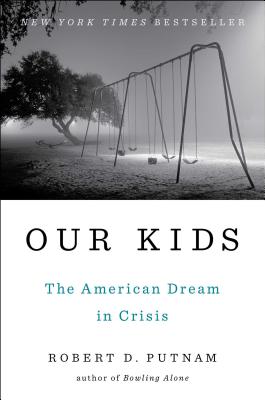Our Kids: The American Dream in Crisis
Robert D. Putnam

I picked this up after reading a review, having enjoyed his book “Bowling Alone.” As I’m sure others have said, this book is more of an aggregation of reasonably well-known results from other social science researchers than a presentation of original research (at least on the quantitative side). That’s not necessarily a knock against it.
The main thesis is that in mid-century America, there wasn’t (too) much separation between the lives and life-chances of children raised in upper and lower class families, but that over the last 50-odd years, a wide gap has opened up. Putnam presents a wide range of “scissors charts” showing the widening gap between classes in a variety of respects, including likelihood of being raised by two parents, access to early childcare, access to education, community support, etc. Virtually anything good you can think of for a kid. Although Putnam focuses on parental education as the key class indicator, he says that any of the indicators you might think of are, unsurprisingly, highly correlated.
The evidence is quite convincing and I have no quibble with Putnam on that front. However, I’d make two criticisms of the book, which left me somewhat unsatisfied. First, I would say he treats the midcentury situation as a sort of status quo, and spends the book trying to figure out what has gone wrong recently. This is understandable given that Putnam himself grew up in the midcentury era, so it is his point of reference, and given that the time series of data he works with generally begin in the midcentury era. However, the work of Piketty has (in my view) quite convincingly shown, using very long time series of wealth and income data, that it was in fact the midcentury period of relative economic equality that was a historical anomaly, and that the current situation of high inequality and low mobility is the historical norm. That’s not to say that we need to accept the current situation, but rather that the focus should be on what the special conditions were that created the midcentury situation as opposed to what’s wrong today, per se. They are related, but different, ways of asking the same question. I’m very surprised that Putnam didn’t so much as mention Piketty (as far as I remember).
This brings me to my second criticism: I think Putnam soft-pedals the conclusion. Possibly because he doesn’t take the long perspective of Piketty, his recommendations come across as surprisingly mild. Indeed, from the vantage point of a couple of weeks after having finished the book, I can barely remember what they were. I remember something about expanding the earned income tax credit and something about expanding formal mentoring programs for low-income kids. On the face of it, I think that it is clear that this kind of tweaking is going to do nothing to solve the huge systemic problems that Putnam is documenting. I think only much more radical solutions would even stand a chance of working: a comprehensive effort to crush income and wealth inequality through a substantial reworking of the tax code; probably a universal basic income; and increased direct government provision of public options in areas such as health care, early childhood education, and higher education; a rollback of the carceral state. I can’t say I’m exactly surprised that Putnam doesn’t go for this program. (Though Bernie Sanders might!)
Very relevant to all of this is this piece, by one of my favorite internet writers: http://www.interfluidity.com/v2/5876..... I’m largely convinced at this point that there is no such thing as a society with high inequality and high economic/class mobility. Those at the high end have too much incentive to defend their privilege and it is too easy for them to do so. Thus, the only way to give lower-class kids a good chance is to compress the income and wealth distribution, as happened in midcentury America due to a confluence of policies and other forces, and as happens in the Nordic states today as a matter of policy.